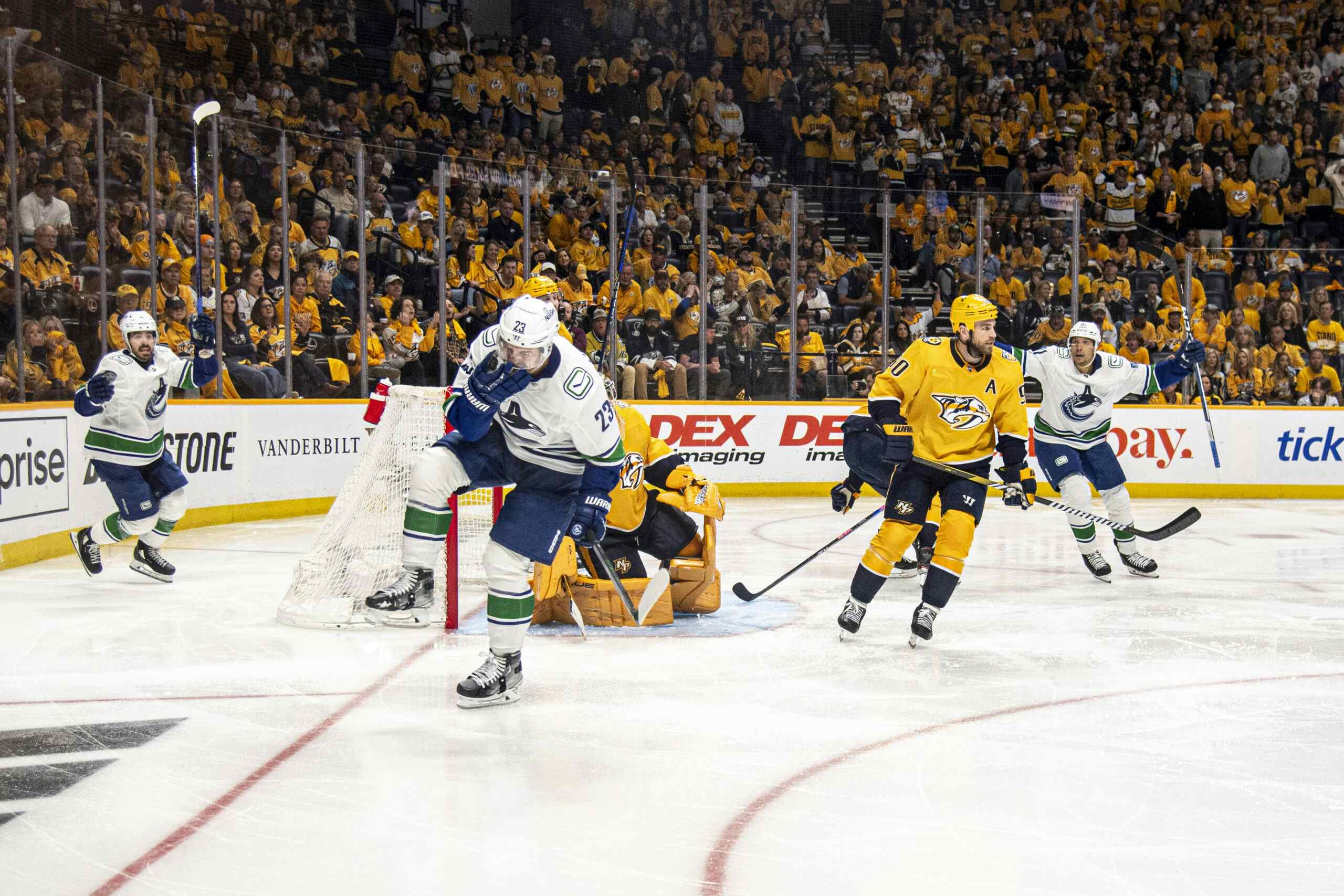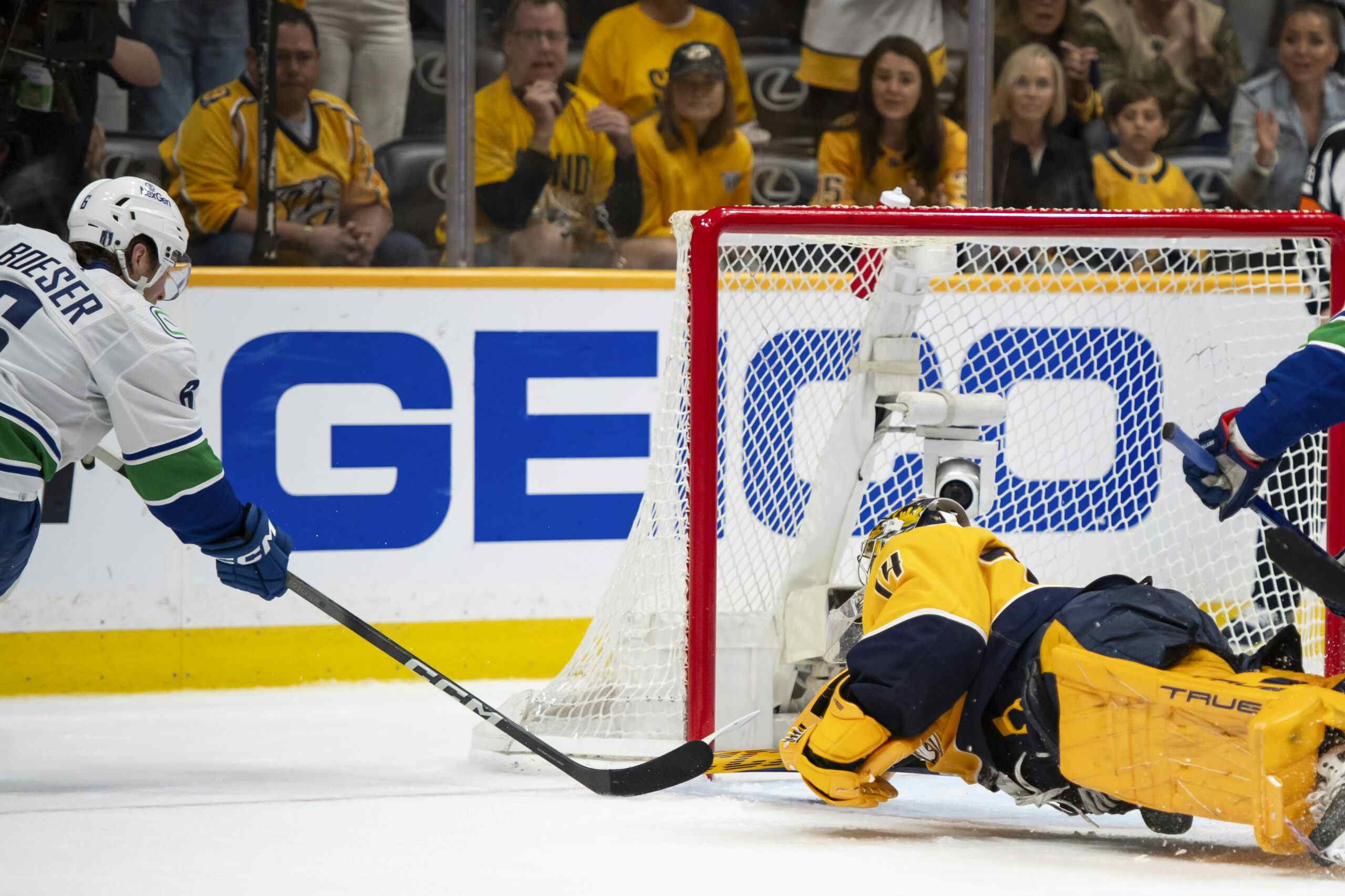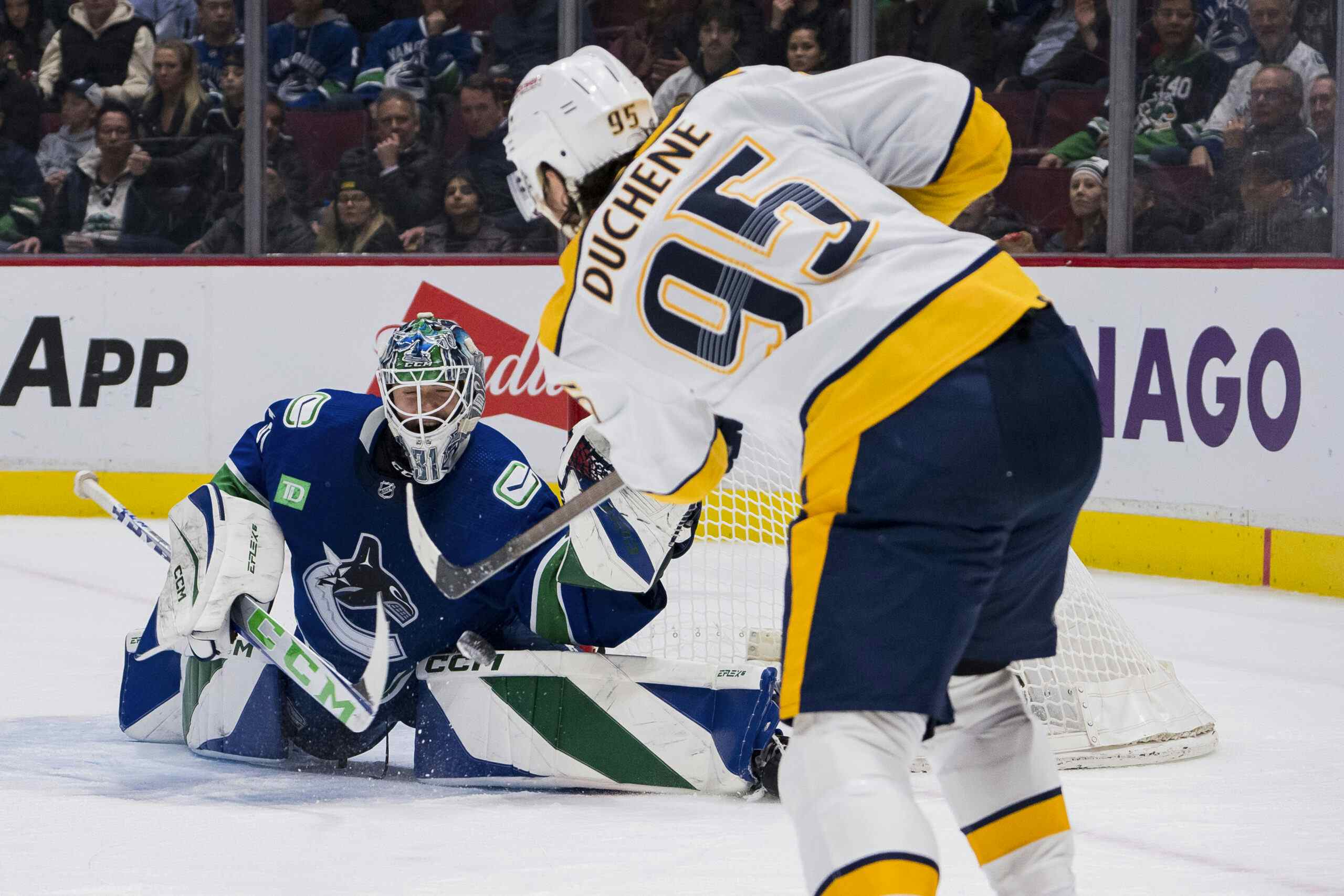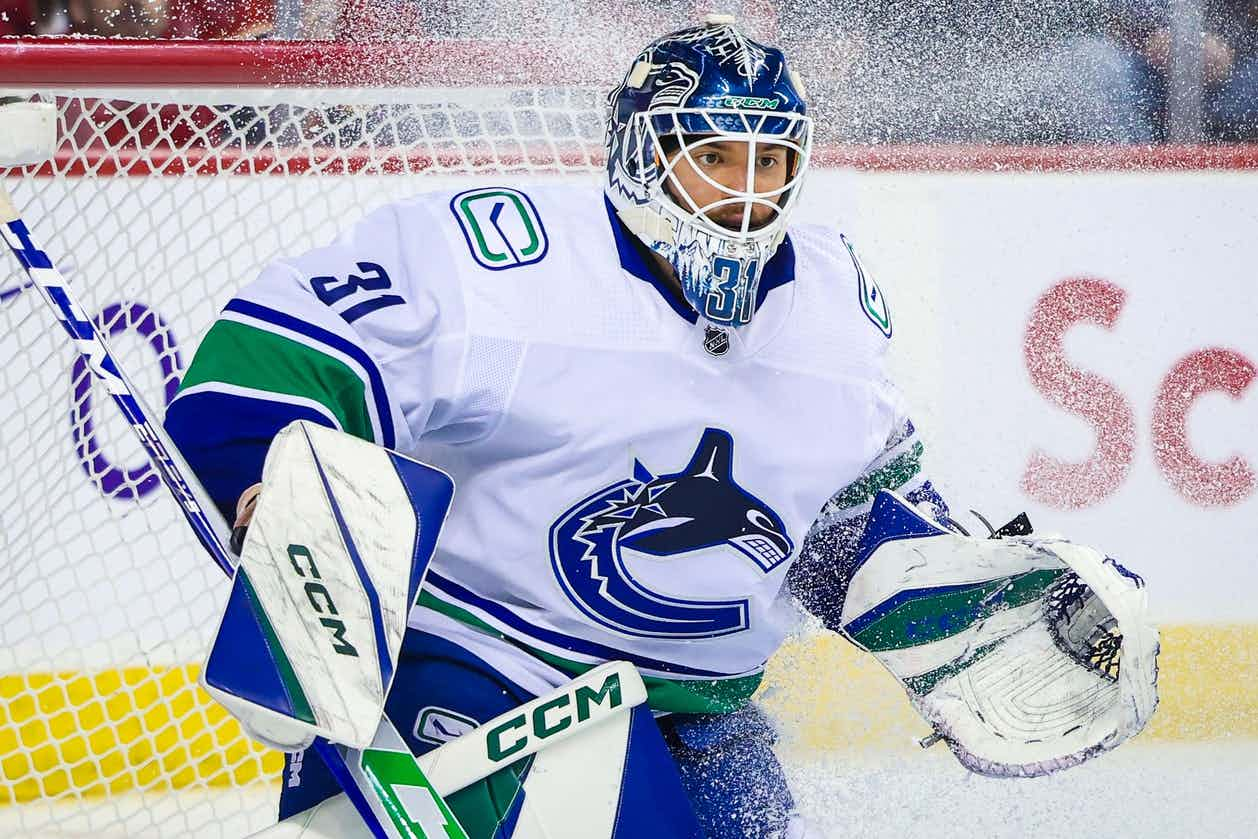The Canucks Have a Bold Strategy for Defending Leads: Bleed Scoring Chances and Ride Percentages Until There’s an Empty Net
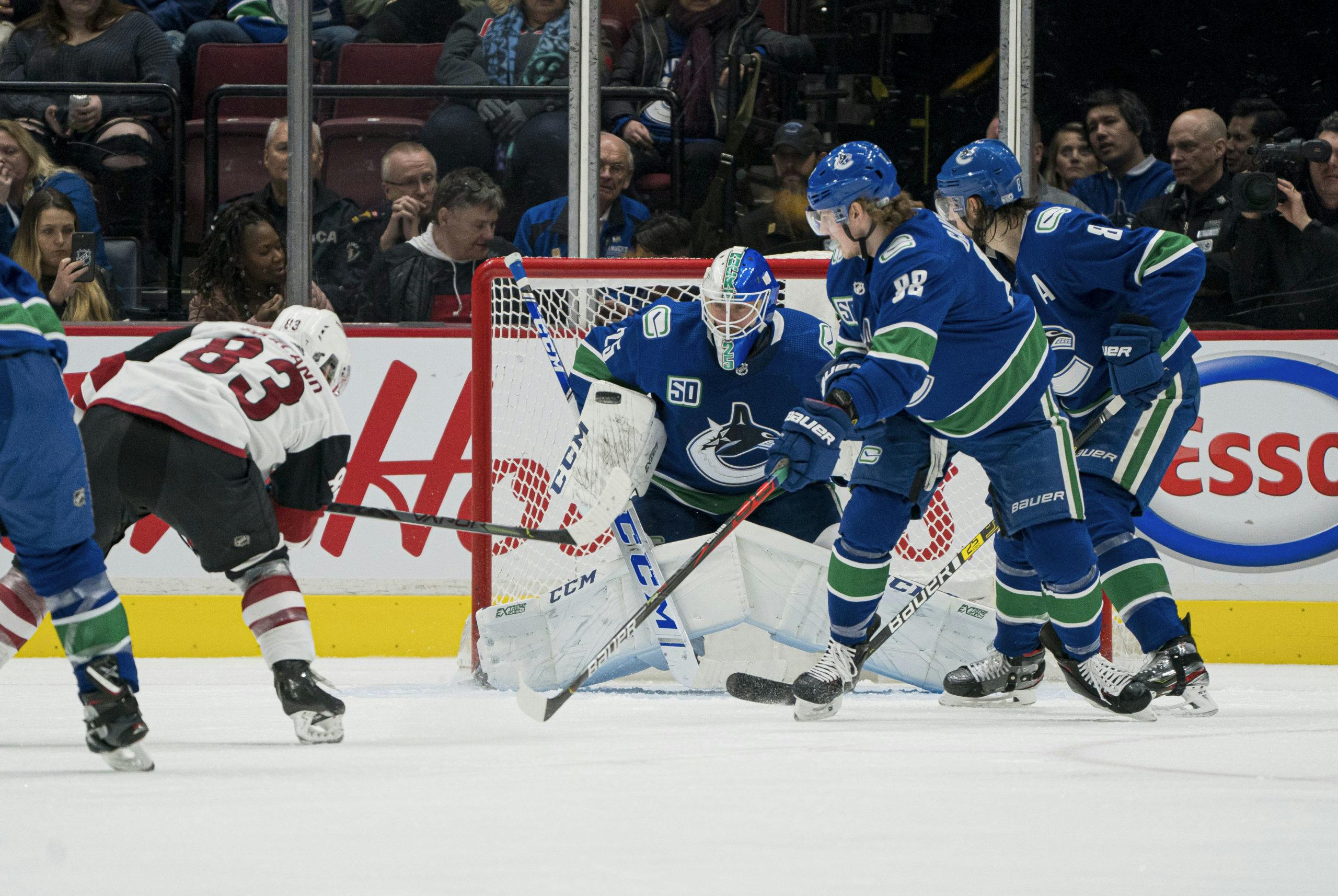
By Jeremy Davis
4 years agoPrior to this recent slide, the Vancouver Canucks were one of the league’s hottest teams, winning 14 times in a 17-game stretch from December 19th to February 1st, securing the top spot in the Pacific Division.
Much attention has been paid to their ability to close out hockey games, particularly with the advent of Loui “The Closer” Eriksson (a nickname I love, by the way) hopping over the boards in late lead situations and manufacturing empty net goals, sometimes in glorious fashion.
Less attention has been paid to the Canucks’ strategy to hold leads up until the net is empty: bleeding scoring chances and relying on goaltending until empty netters bail them out.
It caught my eye some time ago that the Canucks tend to give up a lot of ground while holding leads. To be sure, every team tends to be outshot while leading in games (that’s the nature of score effects), but the Canucks’ method of “shutdown defence” is particularly leaky.
Heading into last night’s game against Minnesota, the Canucks allowed more scoring chances per hour at 5-on-5 while up by a goal than any other NHL team, and the second highest expected goals per hour.
The stats community tends to frown upon the practice of binning, in which you focus on small, broken down samples instead of analyzing the whole and adjusting each portion for context. In that vein, I’ll also note that the Canucks have the fourth worst score-adjusted scoring chances against per hour. However, the interesting part of this story is just how wildly the Canucks’ shot numbers swing depending on the score, so I’ll be indulging in a bit of binning today.
Take this array of heat maps from HockeyViz.com for example:
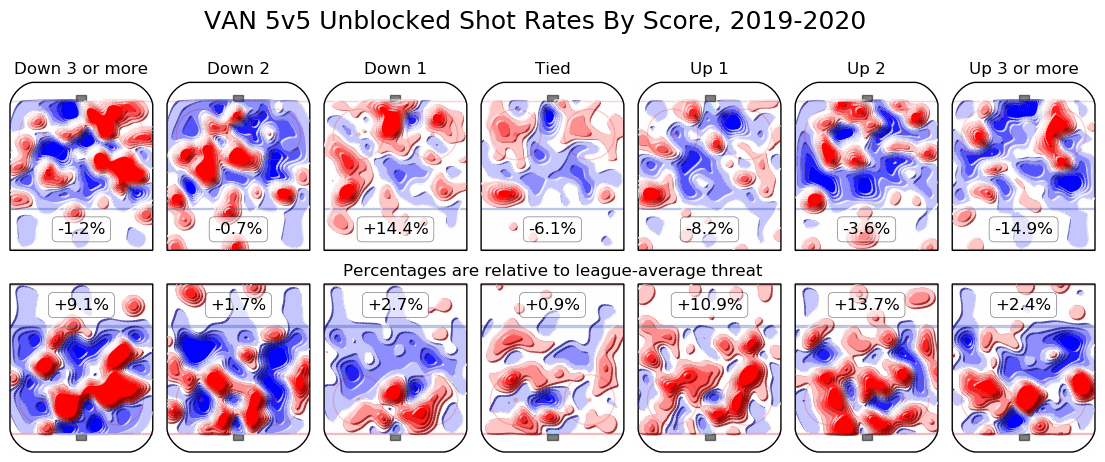
Each individual section notes the team’s threat for and against versus the league average in that score state. There are a couple of fascinating takeaways here. One is the +14% offensive threat relative to league average while down a goal. The Canucks clearly know how to turn up the heat when chasing in a close game, and they can do it without giving up much defensively.
The other takeaway is that the complete opposite happens when the team is up by a single goal. Their offence tanks (-8%) and the defence becomes utterly porous (+10%). Up two goals, the Canucks defence gets even worse, but their offence creeps closer to league average – likely because they become relaxed in defending a lead and focus less on the “shut down” process (which in their case seems to shut down their own offence more so than their opponent’s).
I have a couple of theories about what drives these wild discrepancies. It’s traditional in hockey to lock down a one-goal lead, especially late in games. That results in less offence, but in the modern NHL this strategy frequently results in allowing a high volume of scoring chances against anyway because you’re letting your opponent (often deploying their best players at this point) dictate how the game is played. The goal of defending the zone is reduced to clearing the puck beyond the blue line and allowing the opponent to regroup for another wave of attack.
I’ve plotted the Canucks shot share (at 5-on-5 with a 1-goal lead) over the course of their games, along with the league average to compare against. The Canucks are particularly permissive in the last five minutes of hockey games, which is especially indicative that the team is desperately trying to go into all-out lock down mode and forego any offensive push.
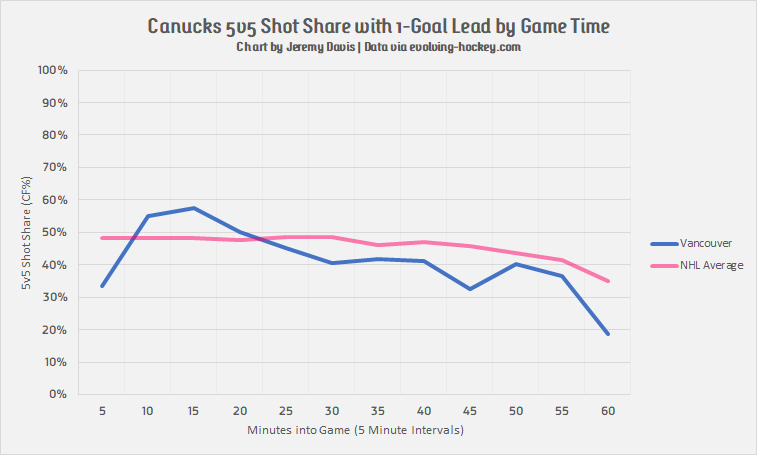
Beyond tactical strategy, the players on the ice play a big role here. Holding close leads late in the game is the realm of the fabled defensive specialist. The problem is, sometimes defensive specialist is actually just code for “non-offensive player”. The result in those cases is that even if chances against are reduced slightly, chances for are reduced even more, and the “lock down” becomes a net negative. Other times, the defensive specialists allows even more chances than their offensive counterparts. The Canucks have some of those guys too.
Up a goal, the Lotto Line’s ice time gets reduced, while ice time increases for the Horvat line and the fourth line. That’s a lot of ground to give up when those lines exchange ice time.
Vancouver Centres – 5-on-5 Expected Goal Metrics with 1-Goal Leads
| Player | Position | TOI | xGF/60 | xGA/60 | xGF% |
| Adam Gaudette | C | 67.3 | 3.36 | 2.76 | 54.9 |
| Elias Pettersson | C | 106.0 | 2.84 | 2.69 | 51.4 |
| Bo Horvat | C | 122.2 | 2.21 | 3.25 | 40.4 |
| Brandon Sutter | C | 45.1 | 1.00 | 1.81 | 35.6 |
| Jay Beagle | C | 70.5 | 1.33 | 2.66 | 33.3 |
On defence, the biggest change is an increase in ice time for Alex Edler and Tyler Myers and a corresponding decrease for Quinn Hughes and Chris Tanev. Given that Quinn Hughes has actually been their best shutdown defender, this is also resulting in a decrease in effectiveness.
Vancouver Defencemen – 5-on-5 Expected Goal Metrics with 1-Goal Leads
| Player | Position | TOI | xGF/60 | xGA/60 | xGF% |
| Quinn Hughes | D | 120.3 | 3.37 | 2.34 | 59.0 |
| Christopher Tanev | D | 123.6 | 2.02 | 2.38 | 46.0 |
| Tyler Myers | D | 138.6 | 2.83 | 3.46 | 45.0 |
| Jordie Benn | D | 62.8 | 2.10 | 2.66 | 44.1 |
| Troy Stecher | D | 119.0 | 1.84 | 2.58 | 41.7 |
| Alexander Edler | D | 130.8 | 1.85 | 2.82 | 39.6 |
| Oscar Fantenberg | D | 63.6 | 1.27 | 4.27 | 22.9 |
The current score-based deployment seems to be doing more harm than good for the Canucks. These numbers indicate that the Canucks would be better off riding their offensive units (i.e. Pettersson’s line and the Hughes pairing) while up a goal. Naturally, those players can’t play all the time, but perhaps a two or more goal lead is a safer time to let off the gas. Whatever the options for change might be, it’s clear that the current strategy comes with significant risk, even if the results have been good so far.
Riding the Percentages
If the shot metrics and expected goal rates have been so bad, then why have the Canucks continued to close out games in which they’ve led?
The answer is that they’ve been riding some pretty significant percentage waves. Their PDO (the sum of on-ice shooting percentage and save percentage) while leading on the scoreboard is currently fifth best in the NHL, buoyed largely by a shooting percentage of 11% (the second best rate in the NHL in that situation). Their 5-on-5 save percentage has actually been a little bit underwhelming, but the overall culmination of the two has allowed them to bump a pretty miserable 43.9% expected goals percentage to a 49.4% actual goals percentage at 5-on-5 while leading. That’s a big enough swing to go from ninth worst in one category to ninth best in the other.
Should the Canucks then be concerned about some regression in this regard? I think the answer is unfortunately yes. If the Canucks’ percentages were supportive more by save percentage, I’d be inclined to give Jacob Markstrom the benefit of the doubt, based on the fact that his newfound high caliber form actually seems fairly sustainable. But the high shooting percentage is a different animal.
A lot of that impressive shooting percentage is driven by Elias Pettersson, who is shooting at a wild 36.8% at 5-on-5 with a lead. Even for Pettersson, that seems a tad high. I’d also be concerned that Tim Schaller, Antoine Roussel, Tyler Motte and Brandon Sutter are all shooting over 15% in this situation. Most other forwards are converting at a reasonable rate, and then you’ve got Bo Horvat at 0% – that’s got to regress in an upward direction at some point.
All in all though, their results with leads suggests that they’ve been lucky with leads to some extent. At some point, you’d like to see the Canucks balance out the shot clock a bit more when playing with a lead – that would be more indicative of long term sustainability.
Against the Empty Net
Hanging on by their teeth seems like a risky strategy, but when the Canucks manage to hold the lead until their opponent pulls their goalie, everything changes. When the Canucks are down six men to five as opposed to being at even strength, they suddenly flip a switch and put the game on ice, led by the newly minted “Insurance Line” of Bo Horvat, Loui Eriksson and Tanner Pearson.
Up one goal at 5-on-5, the Canucks are surrendering 2.85 expected goals against per hour, the second worst such rate in the NHL. Up one goal with the opposing net empty, the Canucks are surrendering 2.81 expected goals per hour, the fifth best such rate in the NHL. They actually decrease the their expected goals against rate despite the opponent another player on the ice. The Canucks are one of only four teams in the NHL who improve their defence in against-empty-net situations – the others being Vegas, Washington and Toronto.
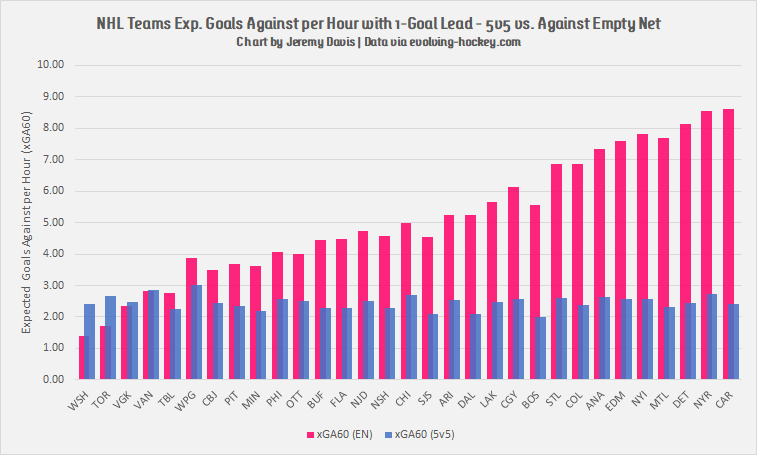
Interestingly, the Insurance Line actually has some of Vancouver’s worst xGA rates when faced with an empty net. The Lotto Line again dominates in this regard, but it’s the Insurance Line that is converting on empty net goals, and thus they get the lion’s share of the credit for closing out games. And that credit is justly deserved, as Horvat, Pearson and Eriksson rank 1, 2 and 3 in empty net points since January 1st.
While the road that leads them to the empty net may be rocky and in need of some attention, there’s no doubt that the Canucks are dynamite once they get a glimpse of that yawning cage. The concern is, as they approach the stretch drive and look toward the playoffs, can they rely this heavily on shooting luck and goaltending to keep them afloat until an empty net presents itself?
Recent articles from Jeremy Davis

